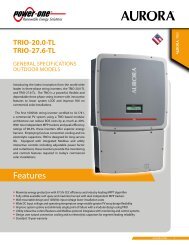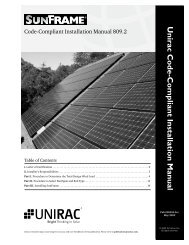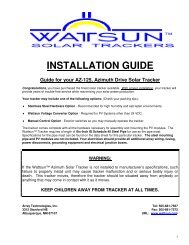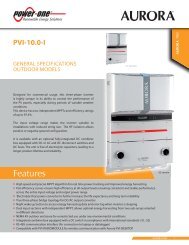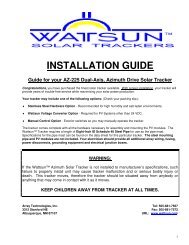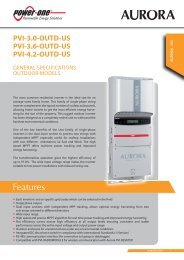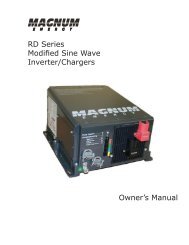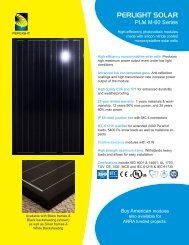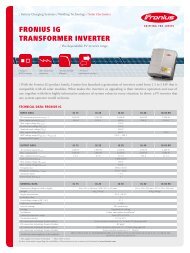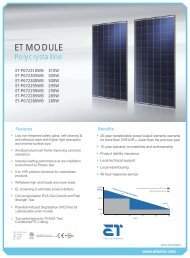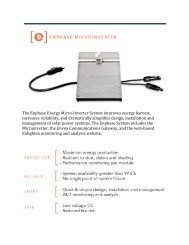MS Series Owner's Manual - Magnum Energy
MS Series Owner's Manual - Magnum Energy
MS Series Owner's Manual - Magnum Energy
Create successful ePaper yourself
Turn your PDF publications into a flip-book with our unique Google optimized e-Paper software.
Appendix B - Battery Information<br />
B-5 Battery Bank Sizing Worksheet<br />
Complete the steps below to determine the battery bank size required to power your AC loads:<br />
1. Determine the daily power needed for each load<br />
a) List all AC loads required to run; and<br />
b) List the Watt-Hours for each load (see table B-1 for common loads/wattage); and<br />
c) multiply by how many hours per day (or a fraction of an hour) each load will be used; and<br />
d) multiply by how many days per week you will use the listed loads; and<br />
e) divide by seven = Average Daily Watt-Hours Per Load.<br />
Average Daily Watt-Hours Per Load<br />
AC load Watt-Hours (x) hours per day (x) days per week (÷7) = total power<br />
2. Determine the total power needed each day for all the loads.<br />
• Add the Average Daily Watt-Hours Per Load together = Total Daily Watt-Hours.<br />
3. Determine the battery Amp-Hour capacity needed (inverter battery voltage)<br />
to run all the loads before recharging.<br />
• Divide the Total Daily Watt-Hours by the nominal battery voltage<br />
of the inverter (i.e., 12, 24 volts); and<br />
÷ ___ =<br />
• Multiply this by how many days the loads will need to run (days of storage)<br />
without having power to recharge the batteries (typically 3 to<br />
5 days of storage) = Storage Amp-Hours. x ___ =<br />
Total Daily Watt-Hours<br />
4. Determine how deeply you want to discharge your batteries.<br />
• Divide the Storage Amp-Hours by 0.2 or 0.5 to get the Total Amp-Hours:<br />
a) 0.2 = Discharges the batteries by 20% (80% remaining), this is considered the<br />
optimal level for long battery life; or<br />
b) 0.5 = Discharges the batteries by 50% (50% remaining), this is considered a<br />
realistic trade-off between battery cost and battery life.<br />
Total Amp-Hours<br />
Additional compensation:<br />
Low battery temperature: If the batteries are installed in a location that will be exposed to low temperatures,<br />
the available output will be less. In these instances, you will need to determine the lowest temperature the<br />
battery bank will experience and multiply the Total Amp-Hours by the Multiplier below.<br />
Temperature 80F/27C 70F/21C 60F/15C 50F/10C 40F/4C 30F/-1C 20F/-7C<br />
Multiplier 1.00 1.04 1.11 1.19 1.30 1.40 1.59<br />
Inverter efficiency: When the inverter is used in a back-up power application the inverter efficiency will not<br />
be a large concern; however if the inverter is the primary AC source for the calculated load, the Total Amp-<br />
Hours should be multiplied by 1.2 to factor in an average 80% inverter efficiency.<br />
© 2009 <strong>Magnum</strong> <strong>Energy</strong> Inc.<br />
Page 53




